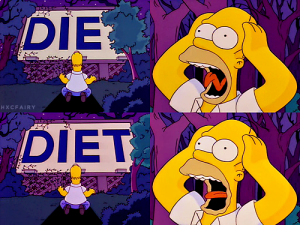
Diets, diets, diets…
It’s all the craze lately isn’t it? 30 Day cleanses, celebrity endorsements, sugar free this, paleo that. It’s hard not to be a little curious and question whether one diet is right for you. The question of which one is best for weight loss is certainly something that has been brought up in conversation with me in the last month or so. My answer has remained the same though: whichever diet or plan you can sustain for the long term is the diet that is right for you.
Those who follow the Facebook page must think I sound like a broken record, but the fact of the matter is, all health related goals should be made with a long term view. It should fit your lifestyle, and it definitely should take into account your personal preferences if you want to succeed, because what Pete Evans (Chef from My Kitchen Rules) may eat may not be what you want on your plate every day. Each person’s individual needs are different.
Be consistent with your plan, be flexible enough to enjoy a variety of foods, and be patient! I can’t stress that last point enough. Ups and downs are inevitable, so don’t beat yourself up and instead remain focus on the overall goal.
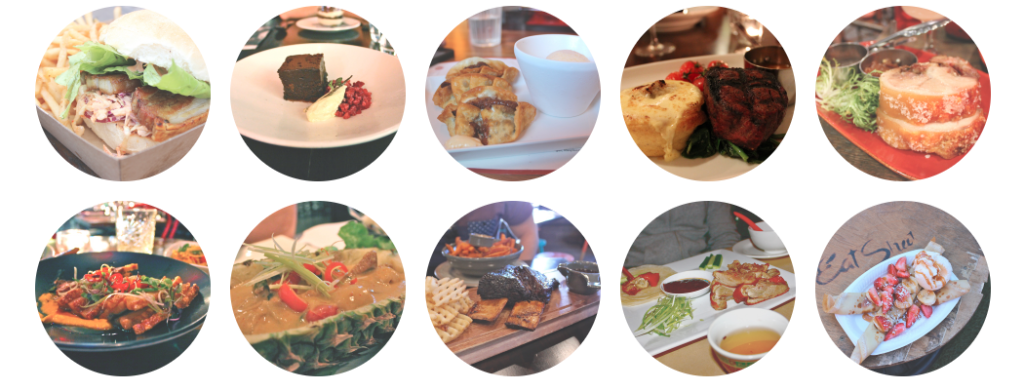
Strict ‘all or nothing’ approaches to food plans for clients are common amongst personal trainers and nutritionists. Often they result in failure due to their lack of flexibility. I’m all for being fit, healthy, and looking the part, but if a diet doesn’t have variety or allow me to indulge in foods I love, I’m not interested. Nonetheless, there is a diet option where you can literally, ‘have your cake and eat it too,’ and that’s by applying the moderation guideline. The moderation guideline is the 10-20% rule which is outlined in greater detail by leading nutritionist Alan Aragon.
In essence, the 10-20% rule allows you to eat whatever you want but still look great naked! Well, not quite, but with all things in life, everything should be in moderation. The basis of your diet should still come from whole and minimally refined foods. Reaching your minimum daily protein and fat intake (which varies for each individual) is still vital. If you are ticking these boxes, then consuming your go to indulgence foods is perfectly fine, as long as they are in moderation (10-20% of your daily Calorie target). Often dieting is too much of a psychological battle to stay within the parameters of a food plan because of lack of flexibility and variety, but with the 10-20% rule, this allows for indulgences more often than just the common ‘cheat meal.’ Of course, if someone chooses to have 0% of their food coming from sweets or processed food, that’s also perfectly fine.
As Alan Aragon has said, “Honouring personal preference is one of the most powerful yet underrated tactics for achieving optimal health and body composition.” Remember though, greater dietary flexibility is achieved by how high or low your physical activity levels are. So basically, consistent exercise is very important.
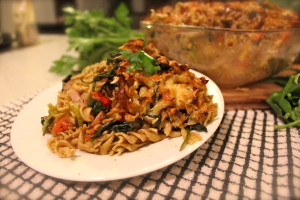
Who doesn’t love pasta?
Using wholemeal pasta for extra fibre (more than double fibre content of normal pasta), we combined basil flavoured tuna with a bunch of vegetables to make this. Pasta is more calorie dense than other foods and is often vilified, but eaten in a sensible serving is completely fine.
May have included a couple of Tim Tams for dessert… 😉
—
Ingredients:
- 500g wholemeal pasta
- 2 teaspoons olive oil
- 4 stalks of spring onions, finely chopped
- 2 garlic cloves, crushed
- 2 sticks celery, finely chopped
- 250g cherry tomatoes, halved
- 120g baby spinach
- 1/4 cup basil pesto
- 4 95g cans of Sirena Basil Infused Tuna
- grated light mozzarella cheese to coat
Method:
1. Preheat oven to 180°C. Cook pasta in a large saucepan of boiling, salted water, following packet directions, until tender. Drain.
2. Heat oil in a large frying pan over medium heat. Add onions, garlic and celery. Cook, stirring, for 2 minutes or until onion is soft. Add tomatoes. Cook for 2 minutes. Add spinach and pesto. Cook, stirring, for 2 minutes or until spinach just wilts. Add pasta to pan with tuna (undrained). Season with salt and pepper. Toss gently to combine.
3. Spoon mixture into a ceramic baking dish. Top with cheese. Bake for 20 minutes or until cheese is melted and golden. Stand for 5 minutes before serving.
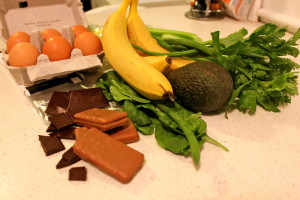
“Clean Eating”… hands down the biggest buzz phrase in the health and fitness industry for the last couple of years, but what does it mean exactly?
Clean eating is defined by eating only the ‘good’, and healthiest of foods whilst elimnating the ‘bad’ foods, which are also known as the ‘dirty’ foods. So eat your fruits and vegetables, but stay away from sugar, and processed foods. Sounds ok in theory right? Well here’s what’s wrong with labeling foods good and bad.
All calories, regardless of what form they come from, are energy. Fruits and vegetables provide a number of vitamins, minerals and fibre, are low in calories per serve (which is known as being nutrient dense) and also provide energy. Most people can do with eating more fruits and vegetables.
Chocolate on the other hand is much more calorie dense (meaning it has a high amount of calories per serve) and also provides a quick burst of energy. What else does it offer though? Enjoyment. Something a diet high in “clean foods” through eating restrictions can lack.
I’m not saying it’s not important to eat healthy foods such as fruit and vegetables, it is vital. But to not include selected foods and label them as ‘bad’ and restricting yourself the satisfaction of eating foods you enjoy (in moderation) could lead to an unhealthy relationship with your diet, not to mention heightened stress levels. Remember what I said above, all food is energy. Meet your energy demands by building the majority of your diet with whole and minimally refined nutrient dense foods, but also allow yourself the flexibility and freedom to eat foods not necessarily regarded as ‘clean’ as well. Therefore your diet includes a wide variety of food types and nutrients, and your not restricted in any way, such as when you’re at a social outing. Everything in moderation. This way, whatever eating plan you are on is easily sustained without being a mental challenge, is well balanced, and satisfies your taste buds!
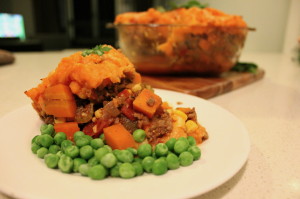
Sweet Potato Shepherd’s Pie
Topped with sweet potato rather than it’s white alternative, this added some extra sweetness and fibre to an already delicious meal.
A good source of protein, carbohydrates, fibre, with a variety of micronutrients (vitamins and minerals), this pie was a delicious choice for warming the stomach during the cooler evenings of August.
—
Ingredients:
500g extra lean beef mince
2 tblp olive oil
2 diced onions
4 crushed garlic cloves
2 tblp Worcestershire sauce
2 stalks celery sliced
2 carrots, chopped into small pieces
1 can diced tomatoes
1 cup corn kernels
1 cup beef stock
1 tblp dried oregano
1 tsp each of thyme & rosemary
1 handful of chopped parsley
cracked pepper
Topping:
2 large sweet potatoes, peeled and cut
1/4 cup low fat milk
1 tblp butter
salt and pepper for seasoning
Method:
1. Steam your potatoes until soft. Mash with milk and butter until smooth. Season with salt and pepper.
2. In pot or pan, heat olive oil and sauté onions until soft.
3. Add carrot, celery, and continue to cook for a further 5 or so minutes.
4. Add mince, cooking through.
5. Season with thyme, rosemary, garlic, oregano, pepper and worcestershire sauce.
6. Once all cooked, add diced tomatoes, stock, corn and parsley. Simmer for 30 minutes.
7. Preheat oven to 180C
8. Add meat mixture to an oven proof dish and top with sweet potato mixture.
9. Bake in oven for 20-30min until bubbling.
10. Serve with steamed vegetables or peas.
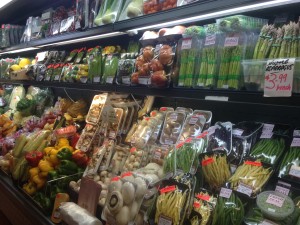
Superior Fruit Graceville
I’m sure many of you are familiar with, have seen or have heard of the glycemic index (GI). You know, those commercials and food labels that tell you why a particular food is more healthy because it is ‘low GI’. In short, the GI is a measure of how quickly a given food can raise blood sugar. The test is done solely on a specific carbohydrate food with a score between 1-100.
High GI foods such as sugar, white potatoes, cereal etc raise blood sugar more quickly, thus are scored higher. Low GI foods such as whole grains, nuts and vegetables do not cause the same rises in blood sugar, so are scored lower… But, do all the meals we consume only consist of high GI foods, or low GI foods? No. They are often a mix of both.
Consuming a high GI food (for example white potatoes) as part of a mixed meal of lower GI foods (vegetables, legumes) with a lean protein, would more than likely mean the overall GI of the meal is quite low. The vegetables and legumes in this case may slow the digestion of the white potatoes.
What does this mean for you?
Well, while you may see a lot of marketing to do with high GI and low GI foods, or have heard of people cutting out potatoes because of their GI score, just remember the GI index should not govern someone’s carbohydrate choices exclusively. Many different types of food both low and high GI have a wide range of vitamins and minerals which can benefit your health.
Eat a variety of whole and minimally processed foods and enjoy what is on your plate!
The best diets are the ones that consume all sorts of nutrients, as well as improve the performance, body composition (the amount of lean mass and fat mass present; basically how you look) and health of that individual.
To have a diet which contains all types of nutrients, you need to have VARIETY! Eating the same things each day, even if they are considered ‘good’ foods, means you are likely deficient in other areas of your nutrition.
Eat for your own health, your own performance, and your own body composition, but do yourself the favour and achieve all of that by eating a wide range of foods.
“Variety is the spice of life”

Because of my profession, when I’m partaking in activities that aren’t considered “healthy” such as having a few drinks or eating certain types of food, I’m occasionally questioned from someone. As it happened this week when I was overheard talking about having a few beers early Saturday morning for the Socceroos game, I thought I’d make this point:
Health goes beyond food and exercising. A good social life, building and maintaining quality relationships and a positive mental attitude are also vital cogs in the machine that is optimal health. So if you miss your home cooked meal sometimes to instead be with friends or family to go out, don’t worry about it.
Eating all types of foods from chicken breast to ice cream, or consuming alcohol in moderation is fine as well if your overall nutrient needs are being met. “Clean eating” isn’t something that needs to be done 24/7 to be considered healthy.
I will go out for drinks with friends and I will eat what I want, when I want, but I know myself that I meet my nutritional and exercise needs none the less. Be smart, be flexible, and be a good friend/partner and you can enjoy foods which are often vilified without it affecting your health, as well as maintaining and building the relationships that matter to you.
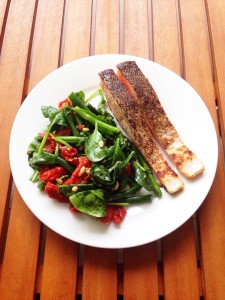
This was one of my lunches this week.
The protein source I opted for on this occasion was salmon for a source of Omega 3s (or ‘healthy fats’ as some people may know it by), which is an essential fatty acid the body can’t produce itself, so must be consumed through foods. As Omega 3s are known to fight disease and promote healthy joints, it’s not a bad choice.
The accompanying salad was a mix of my favourite greens and a sweeter addition in semi dried tomatoes, topped with pine nuts, which were all a good fibre source.
Salmon is one of my favourite meals, but everyone has their own food preferences. Eat to suit your needs and preferences and remember to try to keep consuming a variety of foods to meet your macronutrient and micronutrient needs!
—
FYI here is the recipe with approximate ingredients:
Crispy Skin Salmon with Semi-Dried Tomato Salad
Ingredients:
100g spinach
50g rocket
60g beans
semi-dried tomatoes
2 tablespoons pinenuts
olive oil
salt and cracked black pepper
2 teaspoons chives
2 x 200g salmon fillets
Mix salad into a bowl.
Season the salmon skin with salt.
Heat 1 table spoon olive oil in a medium non stick frying pan over medium high heat. Place the salmon in the pan, skin side down, and cook for 3-4 minutes or until the skin is golden and crispy. Turn the salmon and cook for a further 2 minutes or until your liking.
To serve, arrange the salad on a serving plate and add the salmon.
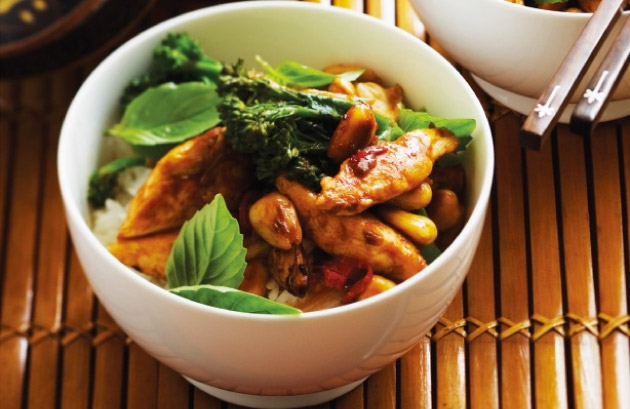
Healthy eating doesn’t have to mean you avoid the foods you love, nor does it have to mean hours and hours of food prep. Check out this recipe below for a simple and easy to prepare Thai dish (who doesn’t like Thai food?) which contains a great mix of macronutrients, and most importantly is delicious!
Method:
Step 1: Heat half the oil in a wok over high heat until just smoking. Add the almonds and stir-fry for 1 minute or until golden. Transfer to a heatproof bowl.
Step 2: Add half the chicken to the wok and stir-fry for 2 minutes or until brown. Transfer the chicken to the bowl with the almonds. Repeat with the remaining chicken, reheating wok between batches.
Step 3: Heat the remaining oil in the wok. Add the onion, broccolini, chilli and garlic and stir-fry for 2 minutes or until the broccolini is bright green and tender crisp. Add almonds, chicken, shallot and chilli jam and stir-fry for 2 minutes or until heated through.
Step 4: Spoon the stir-fry among serving bowls. Sprinkle with basil and serve with steamed rice.









